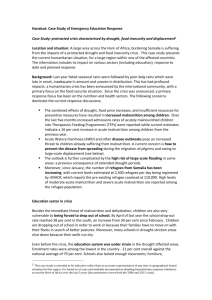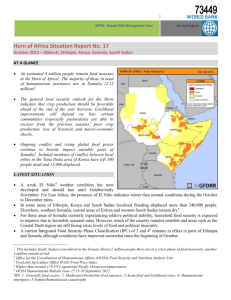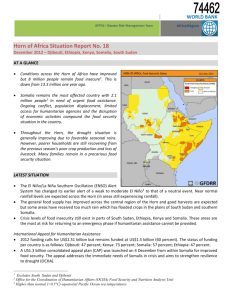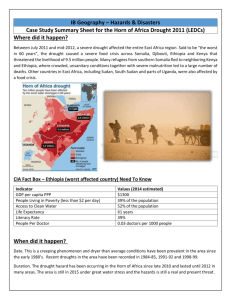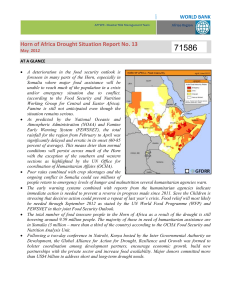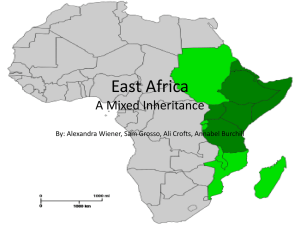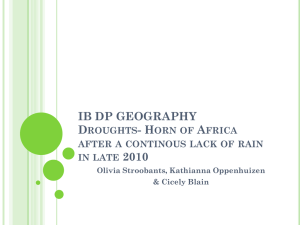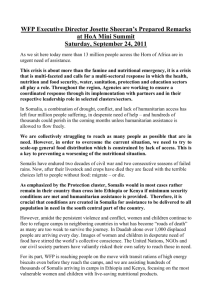AFRICAN UNION
advertisement
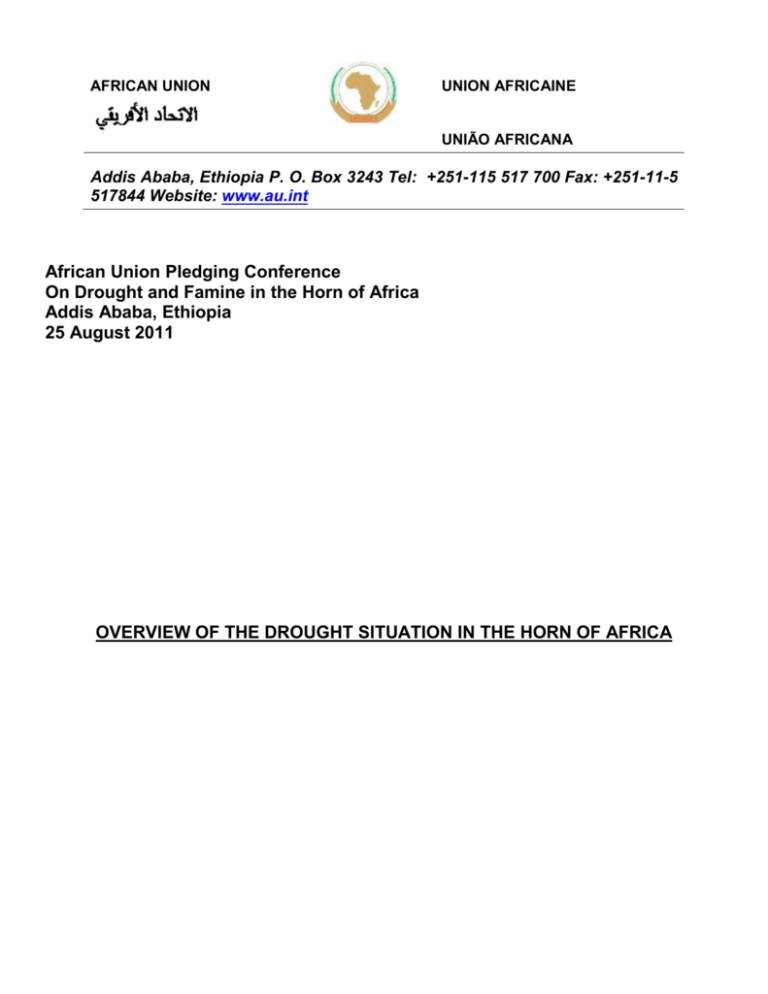
AFRICAN UNION UNION AFRICAINE UNIÃO AFRICANA Addis Ababa, Ethiopia P. O. Box 3243 Tel: +251-115 517 700 Fax: +251-11-5 517844 Website: www.au.int African Union Pledging Conference On Drought and Famine in the Horn of Africa Addis Ababa, Ethiopia 25 August 2011 OVERVIEW OF THE DROUGHT SITUATION IN THE HORN OF AFRICA INTRODUCTION The Horn of Africa is experiencing the most severe food crisis in the world today. Over 12 million people are severely affected in Djibouti, Ethiopia, Kenya and Somalia which is the epicenter of the crisis. The situation has deepened when compared to what obtained six months ago, indeed there is an increase of about 38% in the drought situation to the extent that famine was officially declared by the United Nations on the 20th of July 2011 in the lower Shabelle and Bakool of Southern Somalia. The most affected segment of the population is children facing acute malnutrition, pastoralists, agro-pastoralists, conflict-affected and displaced households, women and children. The humanitarian crisis has been driven by a combination of severe drought, crop failure, rising food prices and the persistent conflict in areas such as Somalia. This has led to massive displacement particularly in Somalia where thousands have been displaced internally and many thousands more have been forced to flee across the border. On the whole, total numbers of refugees in the region has risen to 800,000 while there are 1.46 million internally displaced persons across the four countries that are affected in the Horn of Africa. There is a need to recognize the fact that the prolonged El Niño conditions affected a second consecutive rainy season, and this resulted in the deterioration of food security situation in the drought affected countries. The drought also induced massive reduction in livestock production. The overall effect is that 12.4 million people are severely affected by food crisis and require urgent life-saving assistance. Aiming to promote a shared understanding of needs and priorities, this document provides an overview of the drought situation and humanitarian crisis facing the most affected countries in the region, summarizes key elements of the AU’s response thus far, and sets out challenges and the way forward. REGIONAL SITUATION Drought and famine conditions in the Horn of Africa region coupled with conflict in Somalia, has affected over 13 million people in the region. The most affected countries are Djibouti, Ethiopia, Kenya and in Somalia in particular. The Famine Early Warning Systems Network, FEWSNET, reports that while previous droughts may have lasted longer, the current drought has been particularly severe. Its impact has been exacerbated by extremely high food prices, reduced coping capacity and a limited humanitarian response. After the failure of the 2010 October-December rains and related harvests, the 2011 long rains began late and were erratic. In some areas of northern Kenya and southern Somalia, rainfall was less than 30 percent of the 19952010 average. Towards the end of the last rainy season in May the rains improved. However the gains were short-lived. Rainfall in the last year in south-eastern areas of Kenya was at its lowest since 1950. The timing of the rain that did fall (temporal distribution) was also poor across the region. 2 While the situation is dire in Somalia and the recent influx of refugees, into Djibouti, Ethiopia and Kenya, outbreaks of drought-related animal diseases have affected the pastoralist communities and also contributed to the Cross border migrations: Somali pastoralists crossing the border into Kenya, while thousands of livestock and pastoralists from Kenya migrated to Uganda. More cross border migrations were taking place from Kenya and Somalia into Ethiopia and as a result competition for scarce resources could erupt into resource-based conflicts with local host communities. COUNTRY BRIEFS It is estimated that 3.7 million people in Somalia have been adversely affected by deepening drought and conflict, exacerbated by high food and fuel prices, representing more than a third of the country’s population. The number in crisis has increased by 450,000 since January 2011.The majority of this number is in the South, the most inaccessible region for humanitarian agencies because of insecurity. Furthermore, in July 2011, United Nations declared a state of famine in Southern Somalia mainly in the two regions of Lower Shabelle and Bakool. Food access was far below 2,100 kilocalories per day; acute malnutrition in more than 30 percent of children, one in four children; two adult deaths per 10,000 people every day, or 4 child deaths per 10,000 children every day. Staple cereal prices are at record levels, red sorghum prices have risen 240 percent in the last year. The country has the world’s highest malnutrition rates exceeding 50 percent. The number of IDPs is estimated to be 1.5 million, an increase of about four times more five years ago. Out of this number, about 400,000 are in Mogadishu, the capital. An average of 1,000 new internally displaced persons (IDPs) arrive in Mogadishu on a daily basis. As a direct result of the crisis, over 600,000 Somalis fled to Djibouti, Ethiopia and Kenya. Drought in Djibouti has mainly affected pastoralists because of late and erratic rainfall over two rainy seasons. The number of affected people is over 120,000 and badly in need of emergency assistance to manage the situation. Somali refugees continued to find asylum in Djibouti in relatively large numbers, even though not at the rate of influxes into Ethiopia and Kenya.The number of Somali refugees is about 17,000 and depend entirely on food aid. Due to the rise in refugee population, the Government is envisaged to open a second refugee camp in Holl-Holl to ease the capacity of Ali Addeh camp which was constructed to accommodate 7,000 refugees. The malnutrition is about 10.8 per cent in the camp, in addition to a high prevalence of anemia among children and women of reproductive age. The Government of Ethiopia reported that 4.5 million people were in need of humanitarian assistance in particular in the Somalia and Oromia regions. Almost 60,000 school dropouts were reported due to drought. Many people living in areas affected by the drought are also particularly badly hit by rising food prices. 3 In the meantime the country continued to receive refugees from Somalia at an alarming rate. The number of refugees from Somalia arriving per month currently stands at approximately 8,000 persons in the Dollo Ado region. Most of these refugees arrive in very poor health state; malnutrition and mortality rates are very high. A survey in April 2011 found an acute malnutrition rate of 45 percent among newly arrived children under five in the camps at Dollo Ado. The emergency threshold is 15 percent. The number of Somali refugees stood at 158,000. The April-June rains failed in many drought-stricken areas of northern Kenya and the number of people affected by drought stands at over 3.7 million, and about 477,000 of who are Somali refugees. The situation is exacerbated by high food and fuel prices. The price of major grains rose by 160 percent between June 2010 and June 2011. Pastoralists currently have to sell five goats to be able to buy a 90-kg bag of maize compared with just one to two goats in January 2011. Malnutrition rates among children under five years have risen dramatically with up to 37 percent of children under five malnourished in some northern districts– double the emergency threshold of 15 percent. The situation is expected to deteriorate during the year of 2011. In addition to the drought-stricken areas in the country, an average of1,300 refugees are crossing the border into the Dadaab refugee camps in north-eastern Kenya every day. Malnutrition levels among the newly arrived refugees are very high. The camps at Dadaab have been receiving Somali refugees for the past 20 years and have far outgrown their original capacity, thus reaching more than 300 percent capacity. An extension of Ifo camp was opened to ease the congestion. In summary, the Horn of Africa in particular, Somalia, Djibouti, Ethiopia, and Kenya are experiencing the most severe food and humanitarian crisis in the world today. The situation continues to deteriorate, with major implications for peace and development in the region, and beyond. The need for both humanitarian assistance and longer term solutions to the region’s special challenges could not be greater. THE AFRICAN UNION RESPONSE The African Union made an initial financial donation of a total of US$ 500,000 (US$ 200,000 from the Refugees and IDP Fund to UNHCR to cater for the Emergency needs of affected Somalis who have migrated to Kenya and Ethiopia; US$ 300,000 from the Special Emergency Assistance Fund for Drought and Famine in Africa to UNHCR to cater for food items and non-food items of most affected populations inside Somalia). A fund has been created at the African Union Commission which will directly benefit from the financial contributions made. The Chairperson made appeals for increased humanitarian assistance for the Horn of Africa at various levels to the AU Member States, at the highest level of Heads of State and Government, and to the international community as a whole. The Commission also met with different partners to establish joint action. 4 Various missions were undertaken to the most affected countries, namely Ethiopia, Kenya and Somalia and the Headquarters of the Regional Economic Communities. High-level delegations consisted of the High Representative of Somalia, H.E. Jerry Rawlings, and the Deputy Chairperson of the AU Commission and Chairpersons of the PRC Sub-Committee on Refugees, Returnees and Internally Displaced Persons and from Special Emergency Assistance Fund for Drought and Famine in Africa. CHALLENGES AND THE WAY FORWARD While the Pledging Conference is expected to generate funds that fill part of the funding gap particularly, emergency needs, it is essential that a post conference mechanism be developed to determine priority areas intervention based on the following criteria – Magnitude of funding gap, by sector and country, as indicated in the funding gap analysis and OCHA’s objective analysis of needs and shortfalls; Potential for immediate impact on saving lives, the primary objective of the resource mobilization exercise; and Potential for contribution to early recovery and long-term solutions to hunger and food insecurity in the region Other challenges that need to be addressed well beyond the Pledging Conference with African Union include the need address the African Union capacity to respond to emergencies, mitigate and manage disaster risks through effective coordination capability drawing on relevant continental frameworks and commitments, such as the Comprehensive African Agriculture Development Programme (CAADP), the draft Humanitarian Framework Policy and newly established Emergency Sub-Cluster Enhancement of food security for medium and long-term investments as indicated in the Comprehensive Africa Agriculture Development Programme Framework for African Food Security; (FAFS) Creation within the AU Commission a Rapid Response Unit to address emergency situations in Africa such as witnessed in the Horn of Africa; Address the issue of alternative sources of funding so as to make the African Union self-reliant in resolving crisis affecting Africa. 5
